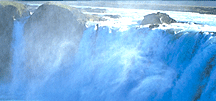|
Day 1 Departure Aberdeen
We embark from Aberdeen, famed as the granite city and many times a winner of the Britain in Bloom competition.
Day 2 Fair Isle / Shetland Islands
At Fair Isle, in the Shetlands, we are welcomed by the 70 or so inhabitants (famed for their knitwear, examples of which we will see) and walk to the bird observatory. We view Grey Seals, Black Guillemots, Puffins, Fulmars, Red-throated Divers, Arctic Skuas and a colony of Gannets and a wonderful spring flora. At the southwestern part of the island we make a zodiac cruise through a wonderful maze of channels and stacks, where we observe Grey Seals and Harbor Seals.
If the weather is poor we will sail by Westray, with impressive bird cliffs at the northern tip, and land at Papa Westray, an inhabited island with accessible and varied bird cliffs, and good photo opportunities.
Day 3 Faroer Islands - Torshavn - Kirkjubøer
Today we arrive at Tórshavn, the capital and cultural centre of the Faroes. Here we are free to shop, to visit the museum or just wander at will. In the harbor the small Faroese boats are a reminder of the Viking origins of the islanders. The walkers among us can make an exciting two hours walk across the hills to Kirkjubøer where they will find a medieval cathedral. In the evening we can enjoy some local culture in town.
Day 4 Mykines - Sørvagsfjordur - Streymoy - Saksun
If the weather is favorable, we plan to land in the morning on the island of Mykines, where thousands of Puffins and other seabirds nest. On wave-lashed Mykines, where colonies of Gannets breed, the local people still catch seabirds for food and the island’s tiny village is one of the prettiest in the Faroes. If we can not land we will sail into Sørvagsfjordur and make a walk along a path from Sørvagur, which is a small Faroes village, to Bøer looking at Eider Ducks, seals and salmon nurseries in the fjord. Continuing along the north side of Streymoy we pass huge seabird colonies. We will try to land at Saksun, tucked away at the head of a fjord which was once a superb natural harbour. Today the bay is full of sand and we can only enter by zodiac at high tide. At Saksun is a Natural Heritage Museum.
Day 5 & 6 Jan Mayen - Nordaustlandet
We sail north to the Norwegian island of Jan Mayen, situated 300 nautical miles north-east of Iceland. During our two days at sea there will be plenty of time to watch for the blow of a Minke, Fin or Blue Whale, which could herald a rewarding encounter with these gentle giants. Perhaps we might run into a pod of Orcas, who can often be quite curious about boats such as ours.
Day 7 Jan Mayen - Kvalrossbukta - KokslettaI
Jan Mayen is a volcanic island of breathtaking beauty and mystique, dominated by Mt Beerenberg. From the slopes of the 2300m volcano, impressive glaciers spill into the sea. Until recently, the island was off-limits as it is a military base, and was rarely visited by tourists, but with permission from the Norwegian authorities we hope to visit the weather station. We will also walk across the island to Kvalrossbukta to look at the remains of a 17th century Dutch whaling station and a substantial colony of Fulmars. We also plan to sail by Koksletta where thousands of Little Auks and Brünnich's Guillemots breed close to a glacier, watched over by piratical Glaucous Gulls.
Day 8 & 9 At Sea
We spend two days at sea, looking out for whalers, dolphins and seals and a variety of seabirds. When we approach the sea-ice at the southern tip of Spitsbergen, we may also encounter moulting Harp Seals.
Day 10 Spitsbergen - Hornsund
Depending on the position of the sea-ice, we cruise the maze of fjords in the spectacular Hornsund area of southern Spitsbergen, which is ringed by towering mountain peaks. Hornsundtind rises to 1,431m while Bautaen shows why early Dutch explorers gave the name ?Spitsbergen? - pointed mountains - to the island. There are also 14 magnificent glaciers in the area but as well as spectacular scenery, the area is renowned for its abundant and varied arctic wildlife. We have very good chances of seeing seals and with a little luck, the very symbol of the Arctic - Polar Bears. We may visit the Polish research station where the friendly staff will give us an insight into their research projects. Behind the station, the mountains are home to thousands of pairs of nesting Little Auks. Bearded Seals often cruise the inner fjords, whose cliffs are lined with colonies of Brünnich?s Guillemots and Kittiwakes. On the tundra we will have good opportunities to observe foraging Barnacle Geese.
Day 11 Ahlstrandhalvøya - Van Keulenfjorden - Recherchefjorden
Today we land at Kapp Toscana on Ahlstrandhalvøya at the mouth of Van Keulenfjord, where piles of Beluga skeletons are a reminder of the 20th century exploitation of these small white whales. Numbers are now recovering and there is a good chance of spotting small groups in the area. We then move to Recherchefjord, where a walk on the fragile tundra which backs the fjord may yield sightings of Reindeer and where we visit the remains of a 17th century Dutch whaling station at Lagerneset. Alternatively we may land at Midterhuken to explore the remains of 17th century English whaling sites. The weather will determine which good options will be chosen in this area.
Day 12 Longyearbyen
We disembark at Longyearbyen, the administrative centre of Spitsbergen, for flights south to Norway and onward to home. Alternatively we may stay on the ship and continue our voyage to North Spitsbergen (MOL05).
Back to Top News
|

